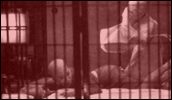Shogun’s Joy of Torture
- Year
- 1968
- Original title
- Tokugawa Onna Keibatsushi
- Japanese title
- 徳川女刑罰史
- Alternative title
- Criminal Women
- The Joys of Torture
- Tokugawa Joy of Torture
- Director
- Cast
- Running time
- 96 minutes
- Published
- 20 March 2001



by Jasper Sharp
Set in the Tokugawa (or Edo) period, the first in Teruo Ishii's Joys of Torture series opens with a montage portraying a succession of women being decapitated, burnt alive at the stake, and torn in two by oxen. The film then adopts a portmanteau approach of three short stories which all culminate in lengthy torture sessions.
In the first, a girl is tortured after an incestuous relationship with her brother and suspended upside-down with her head immersed in the sea until she drowns. Secondly, sexual shenanigans at a nunnery lead to fun with a bathtub of leeches, chili peppers applied between the legs, branding, and multiple crucifixions. In the final and most substantial of the three stories, a sadistic torturer criticises the work of a tattoo artist who has attempted to portray the expression of woman in pain. For the artist's next masterpiece, the torturer offers to demonstrate what this expression really looks like by allowing him to sketch a selection of Europeans accused of entering Japan with the aim of spreading christianity. In the end it is the face of the torturer that ends up being portrayed in the resulting tattoo.
Whatever accusations of misogyny or bad taste can be leveled at this film, it is ultimately a product of its time. During the late 1960s, as censorship patterns relaxed around the world, films such as these were made the world over to pander to audiences clamouring for more and more excesses in their desire to be shocked. Whether in the increasingly sadistic work of Jess Franco in Europe, the low-budget gore films of US independent practitioners such as Robert L. Frost and Andy Milligan, or even the increasing levels of sex and violence in Hammer's films, the boundaries of sadism and nudity were constantly being pushed as an easy way of getting people into cinemas against the now firmly established threat of television.
The rather exploitative video packaging which accompanies this Japan Shock Video release seems to suggest stomach-churning scenes of wall-to-wall sex and sadism. In fact, they're selling this film short by a considerable margin. For a start, like its European contemporaries (for example, Michael Reeves' Witchfinder General, 1968; Adrian Hoven's Mark of the Devil, 1969; or Jess Franco's The Bloody Judge, 1969), the camera remains fairly distanced from the proceedings rather than lurching into extreme gory close-ups, though admittedly the torture scenes here are a little more abundant. By today's standards the special effects, though fairly effective, look basic and perfunctory and the nudity mild.
However, what sets Japanese films of this type apart from similarly conceived offerings from around the world are the higher production values resulting from the conditions under which they were made. Japanese cinema during this time was completely dominated by the studio system. Directors were merely required to churn out a given number of films a year, and as long as the films made money they were afforded a moderate budget and a considerable degree of autonomy.
Because of the consequent financial and professional resources, technical expertise and wider distribution opportunities available under such a system, the Toei-produced Shogun's Joy of Torture looks a good degree more polished than films of this type made outside of Japan and hardly plumbing the tacky, self-conscious depths of later Occidental sex and sadism spectacles like Don Edmonds' Ilsa - She Wolf of the SS (1974) and its sequels. With its colourful art direction, polished cinematography and sombre funereal death march soundtrack, it is undeniably well made.
Straight-faced sado-sexual fantasies such as this and such contemporaries as Woman's Prison (Hiroku Onna-Ro, 1967 - Akira Inoue) and Violated Angels (Okasareta Byakui, 1967 - Koji Wakamatsu) therefore became, and still are, a commercially viable staple of Japanese cinema, mutating into the more overt SM-heavy 'ero-guro' (erotic grotesque) fare by way of the Nikkatsu Roman Porno films of the 1970s.
Technical merits aside, what is most striking about Shogun's Joy of Torture is the literal sombre seriousness of the exercise. Historical veracity is the order of the day, and as such there's an almost academic coldness to the film not found in similarly pitched films made in either Europe or the US. It spawned a quick succession of sequels from director Ishii, all trading on the images of women being broken, branded and bound: Tokugawa: Woman Genealogy (1968); Tokugawa Tattoo History ('69); Decadent Edo Women Genealogy: Brutality, Abnormal, Abusive ('69); Shameless: Abnormal and Abusive Love ('69); Meija Era, Taisho Era, Showa Era: Grotesque Cases of Cruelty to Women ('69); Yakuza Torture History: Lynching! ('69); Porno Samurai Theatre: Bohachi Code of Honour ('73).